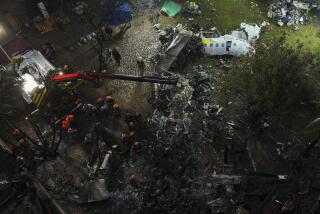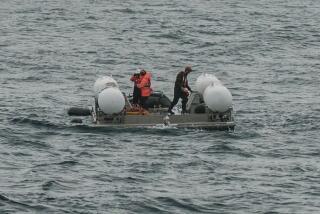Part of Air France jet’s tail is found
- Share via
BOGOTA AND LOS ANGELES — The Brazilian navy on Monday found a huge piece of tail section from Air France Flight 447 floating in the Atlantic Ocean, raising hopes that crews will be able to find more wreckage to help determine what caused the plane to crash.
One U.S. aviation consultant said the almost perfectly intact vertical stabilizer provides evidence that the jetliner broke apart before hitting the water and said it resembles the condition of a tail that was torn off an Airbus that crashed in New York City in November 2001.
The Pentagon confirmed that it had sent two electronic listening devices to aid in the search. The devices are capable of detecting signals from “pingers,” or beacons that all commercial airliners carry, to a depth of four miles.
The Air France Airbus 330 disappeared May 31 en route from Rio de Janeiro to Paris over a section of the Atlantic where the ocean floor is between two and four miles below the surface. All 216 passengers and 12 crew members are presumed to have died. Brazil has recovered 24 bodies.
The listening devices were flown aboard commercial aircraft to Brazil from Washington on Monday morning and were accompanied by a Navy crew. The devices will be towed by two French navy tugboats based in Brazil.
In the 2001 accident, U.S. investigators found that pilots for the American Airlines A300 jet had encountered turbulence in the wake of another jet and that they applied so much force on the rudder that the tail tore off the plane, sending the craft into a sharp dive.
Robert Ditchey, an aeronautical engineer, former pilot and retired airline executive, said he was struck by the similar conditions of the Air France tail and the American Airlines tail. Ditchey said he doubted the tail would have remained so well preserved if it had crashed into the water while still attached to the fuselage.
Investigators have learned that the Air France jetliner’s autopilot was disengaged for unknown reasons about four minutes before the crash.
Ditchey said the new evidence opens the possibility that after the autopilot was disengaged, the plane encountered weather-related turbulence. The pilots may have overcompensated, as pilots did in 2001, and caused the tail to rip off, he said.
In Paris, an Air France pilots union said members should refuse to fly long-haul planes like the Air France Airbus that crashed unless the models are upgraded with improved airspeed detectors.
The call came days after Air France announced it had accelerated a program to replace the three independent flight speed detectors, known as pitot tubes or pitot probes. The airline said the upgrading initiative was conducted “without making any assumptions” that the devices caused the accident.
All of Air France’s long-haul Airbuses now have at least one of the latest pitot models, while nine out of 30 have two new probes, an airline spokeswoman said Monday.
The program to update the planes began April 27 and was accelerated after the crash.
Nevertheless, the union said that, “so as not to reproduce a catastrophe, and while waiting for the results of diverse open investigations,” it suggested that all its pilot members “refuse all flights on A330/A340 lacking at least two modified pitot probes.”
--
Kraul is a special correspondent. Special correspondent Devorah Lauter in Paris contributed to this report.
More to Read
Sign up for Essential California
The most important California stories and recommendations in your inbox every morning.
You may occasionally receive promotional content from the Los Angeles Times.











